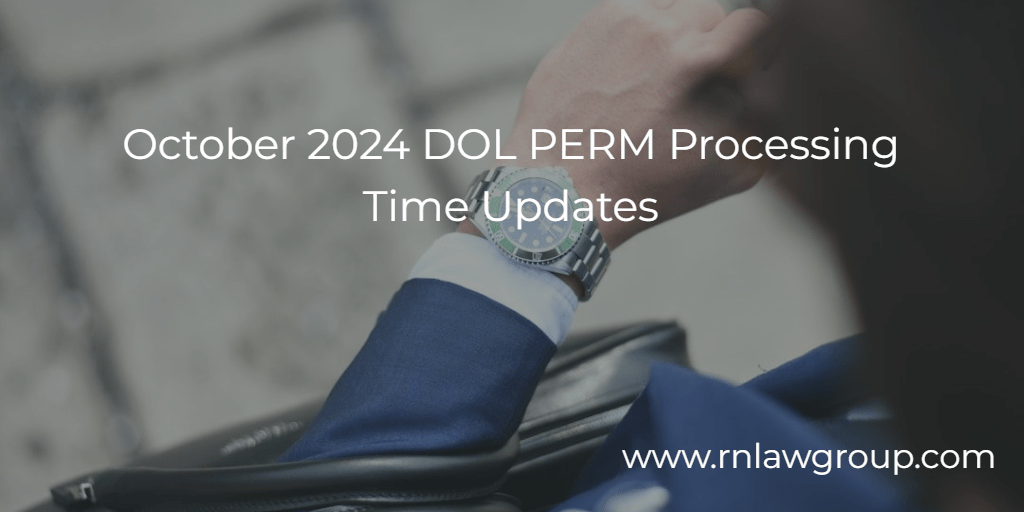
October 2024 DOL PERM Processing Time Updates
The Department of Labor (DOL) issued updated PERM processing times as of October 15, 2024 for PERM applications and prevailing wage determination (PWD) requests. These updates provide important information for employers and foreign workers navigating the employment-based green card process. Understanding the current processing times is vital for strategically managing the various stages of the employment-based green card process. The updated processing times are as follows:
Prevailing Wage Determination and PERM Processing Times
The National Prevailing Wage Center (NPWC) is processing PWDs that were filed in April 2024 for OES wages (standard) and May 2024 for non-OES wages, which includes private wage surveys. Further, the NPWC is processing redetermination requests submitted in June 2024. Currently at Reddy Neumann Brown PC, we are seeing PWDs being issued in about 6 months.
The DOL is processing PERM applications filed in August 2023. On average, the DOL is adjudicating PERM applications in approximately 430 days. Further, the DOL is processing audits for PERM applications filed in December 2022. On average, the total processing time if a PERM application is audited is 453 days. Also, the DOL is processing PERM reconsideration requests that were submitted in April 2023. Currently at Reddy Neumann Brown PC, we are seeing PERM applications approved (if not audited) in approximately 14 months, which is consistent with the average processing times reported by the DOL.
DOL Updates from the 2024 AILA Fall Conference
At the 2024 AILA Fall Conference held on September 27, 2024, updates on the PERM program were discussed, highlighting the transition from the legacy PERM system to the new FLAG system that was implemented June 2023. As of the conference date, only three PERM applications remain pending in the legacy system, which is scheduled to be shut down on December 1, 2024. It is recommended that employers retrieve any necessary information from the legacy system before this deadline. After the legacy PERM system is decommissioned, employers requiring information from it will need to submit a FOIA request.
Since the implementation of the FLAG system, approximately 13,830 PERM applications have been adjudicated, while approximately 180,740 applications are pending initial review. Although the DOL has not yet determined if the efficiencies built into FLAG will help reduce processing times, they are aware of the existing delays and continue to seek improvements. Further, while the DOL has reduced some of its processing times (e.g. PWDs), further reductions may be challenging due to the higher volume of filings received during FY2024. The total number of filings in FY2024 rose by 12% compared to the previous year.
Alternative Options
Employers should initiate the PERM-based green card process as early as possible to avoid issues related to the foreign worker’s temporary work visa status. Moreover, individuals who qualify may explore alternative avenues to the PERM-based green card process. When considering alternatives to the PERM-based green card process, several immigrant visa categories offer potential pathways that may be quicker or more suitable for certain individuals and employers.
EB-1A Extraordinary Ability: The EB-1A category is aimed at individuals who have reached the top of their field, showcasing extraordinary ability in science, arts, education, business, or athletics, as demonstrated by sustained national or international recognition. While the requirements are similar to those of the O-1 temporary work visa, the standards are more stringent. Unlike PERM-based categories, the EB-1A allows foreign workers to self-petition without a job offer or labor certification. This route can be advantageous for individuals from countries with significant visa backlogs, such as India, as it may lead to a faster green card process than the EB-2 or EB-3 categories.
EB-1C for Multinational Managers or Executives: This category is designed for international companies who have an induvial working abroad in a manager or executive capacity and who have a need for that individual to work in that same capacity for the U.S. employer. To qualify, there must be a qualifying relationship between the employer abroad and the U.S. employer, the petitioning employer must be a U.S. employer doing business at least 1 year in the U.S., and the foreign worker must be employed in a managerial or executive capacity for the qualifying employer abroad for at least 1 year in the 3 years preceding the petition and they must be coming into the U.S. as a Manager or Executive. This category, which parallels the L-1A temporary work visa, also bypasses the need for PERM labor certification and may offer a quicker route to a green card for those from countries with long wait times.
National Interest Waiver (NIW): The NIW falls under the EB-2 category, but does not require a job offer, allowing foreign workers to self-petition. Foreign workers must meet the EB-2 advanced degree or exceptional ability standards and show that their work has substantial merit and national importance. Additionally, they need to prove that they are well-positioned to advance their proposed endeavor and that waiving the job offer and labor certification requirements would significantly benefit the U.S.
“Schedule A” Group II Exceptional Ability: A “Schedule A” designation is a provision by the DOL that pre-certifies certain occupations as having a shortage of U.S. workers who are able, willing, qualified, and available. This pre-certification allows employers to bypass the labor market test normally required for the PERM process when hiring foreign workers in these occupations. The Schedule A “Group II” designation applies to foreign workers with exceptional abilities in the sciences, arts, and performing arts. While the employer must obtain a prevailing wage determination from the DOL, there is no need to undergo the lengthy recruitment process or submit a PERM application to the DOL. For a detailed overview, visit Understanding “Schedule A” Group II Exceptional Ability.
EB-5 Immigrant Investor Program: The EB-5 program grants a pathway to permanent residency for foreign investors who make significant investments in U.S. commercial enterprises. To qualify, investors must meet specific capital investment and job creation requirements, along with other complex program conditions. This route not only benefits investors but also provides green card opportunities for their families.
While the PERM-based green card process has traditionally been a key pathway for individuals seeking permanent employment in the U.S., exploring alternative options can present practical and, at times, faster routes for both individuals and employers. The wide range of available immigrant visas accommodates various skill levels, investment opportunities, and business requirements, offering flexibility in navigating the complexities of U.S. immigration laws. By understanding and considering these alternatives, individuals and organizations can make more informed decisions about their immigration options.
As an immigration law firm that has been serving our clients for over 25 years, our team is here to offer prompt, practical, and professional advice, whether you’re a company seeking to hire top talent to grow your business or a foreign worker wanting to develop a career in the United States. If you have any questions, please schedule a consultation with one of our attorneys at https://appointments.rnlawgroup.com/.
By: Krystal Alanis
Krystal Alanis is a Partner at Reddy Neumann Brown PC with over 10 years of experience practicing U.S. business immigration law. Krystal manages the firm’s PERM Labor Certification Department, where she oversees all EB-2 and EB-3 employment-based green card matters. Krystal guides clients from a variety of industries through the maze of the PERM Labor certification process and has handled thousands of PERM applications throughout her career. Krystal guides employers through the I-140 and Adjustment of Status process, and assists clients with temporary work visas. Further, she oversees the firm’s I-9 compliance team where she advises employers regarding Form I-9 Employment Eligibility Verification requirements and conducts internal audits of a company’s I-9 records, processes, and procedures. Additionally, Krystal represents clients in Form I-9 U.S. Immigration and Customs Enforcement (ICE) inspections (Notice of Inspection). Krystal successfully settled a claim with ICE over Form I-9 substantive paperwork violations that led to an 88% reduction in civil fines for her client.

